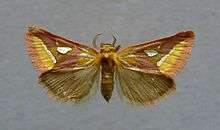Axia (moth)
Axia, the gold moths, is a genus of moths whose precise relationships within the macrolepidoptera are currently uncertain, but they currently represent a superfamily whose nearest relatives include the butterflies, Calliduloidea, Drepanoidea, Geometroidea, Bombycoidea, Mimallonoidea, Lasiocampoidea, and the Noctuoidea. Uniquely, they have a pair of pocket-like organs on the seventh abdominal spiracle of the adult moth[1] which are possibly sound receptive organs.[2] They are quite large and brightly coloured moths that occur only in southern Europe and feed on species of Euphorbia. Sometimes they are attracted to light.[1] The genus was first described by Jacob Hübner in 1821.
| Axia | |
|---|---|
 | |
| Axia margarita | |
| Scientific classification | |
| Kingdom: | |
| Phylum: | |
| Class: | |
| Order: | |
| Family: | |
| Genus: | Axia Hübner, 1821 |
| Synonyms | |
| |
One species, Epicimelia theresiae, was formerly included in this genus, but has since been recognized as distinct; it represents the only other described genus in the family.[3]
Species
- Axia margarita (Hübner, 1813)
- Axia napoleona Schawerda, 1926
- Axia nesiota Reisser, 1962
- Axia olga (Staudinger, 1899)
- Axia vaulogeri Staudinger, 1892
References
- J. Minet (1999). "The Axioidea and Calliduloidea". In N. P. Kristensen (ed.). Lepidoptera, Moths and Butterflies. Volume 1: Evolution, Systematics, and Biogeography. Handbuch der Zoologie. Eine Naturgeschichte der Stämme des Tierreiches. Walter de Gruyter, Berlin & New York. pp. 257–261.
- J. Minet & A. Surlykke (2003). "Auditory and sound producing organs". In N. P. Kristensen (ed.). Lepidoptera, Moths and Butterflies. Volume 2: Morphology and Physiology. Handbuch der Zoologie. Eine Naturgeschichte der Stämme des Tierreiches. Walter de Gruyter, Berlin. pp. 289–323.
- Shen-Horn Yen and Joël Minet (2007) Cimelioidea: A New Superfamily Name for the Gold Moths (Lepidoptera: Glossata). Zoological Studies 46(3): 262-271
Sources
- De Freina, J.J. & Witt, T.J, (1987) Die Bombyces und Sphinges der Westpalearktis.; ISBN 3-926285-00-1
- Firefly Encyclopedia of Insects and Spiders, edited by Christopher O'Toole, ISBN 1-55297-612-2, 2002
External links
- Savela, Markku. "Axia Hübner, 1821". Lepidoptera and Some Other Life Forms. Retrieved August 4, 2018.